UK Warehousing & Distribution Logistics Market Size
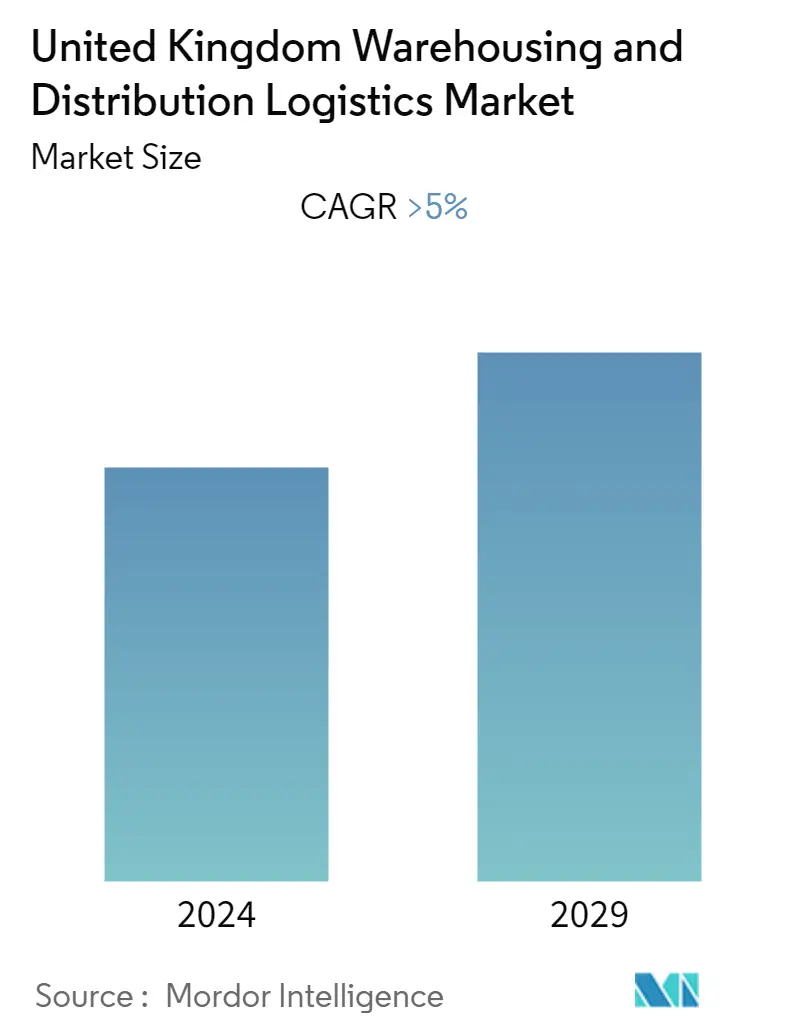
| Study Period | 2019 - 2029 |
| Base Year For Estimation | 2023 |
| Forecast Data Period | 2024 - 2029 |
| Historical Data Period | 2019 - 2022 |
| CAGR | 5.00 % |
| Market Concentration | Low |
Major Players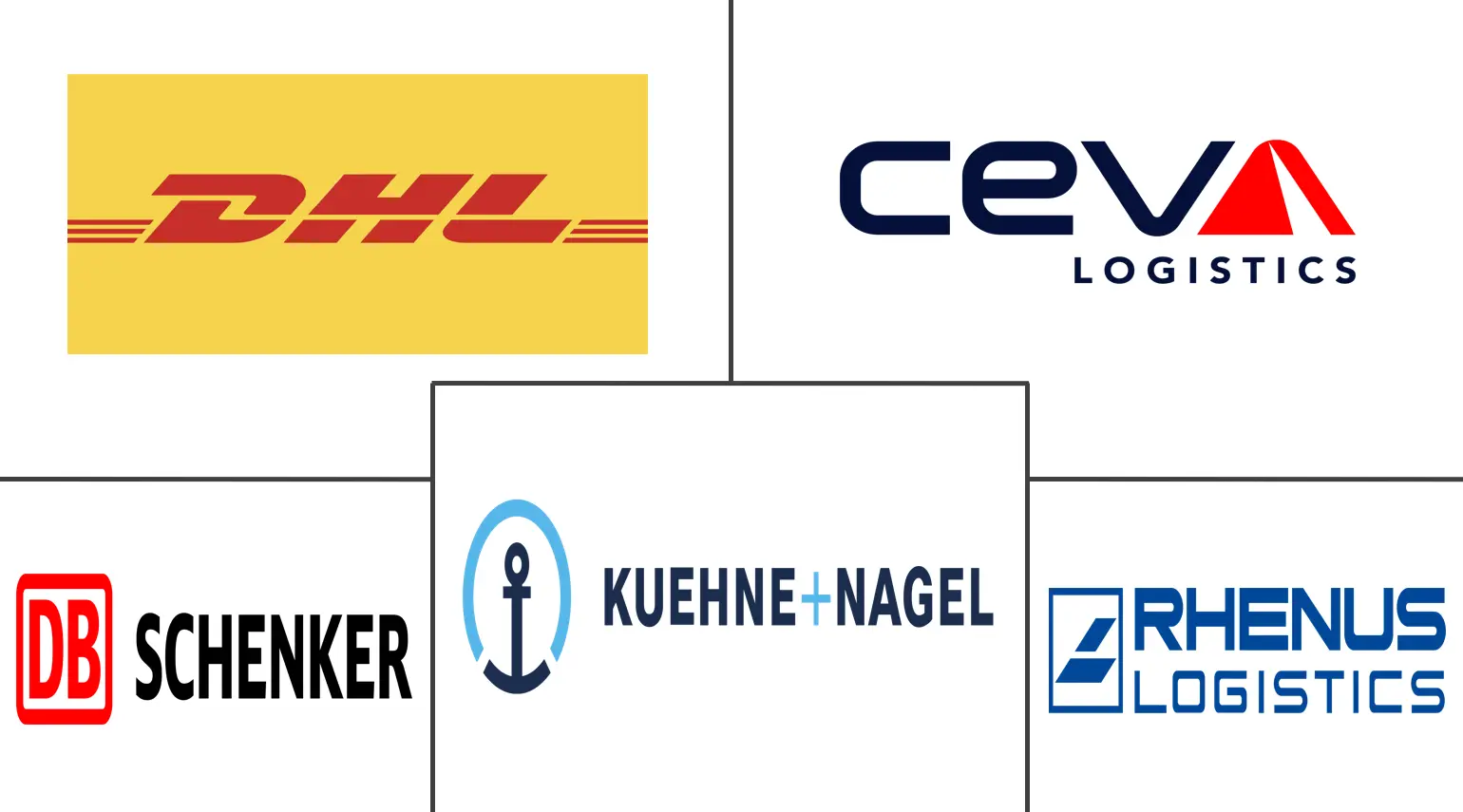
*Disclaimer: Major Players sorted in no particular order |
UK Warehousing & Distribution Logistics Market Analysis
During the time frame of the forecast, the UK warehouse and distribution logistics market is expected to register a CAGR of more than 5%.
- COVID-19 pretty much brought the global flow of goods to a virtual standstill. Industries of all descriptions found it difficult to procure goods. Strict enforcement of border controls led to backups and delays. COVID-19 caused business revenues to plummet, and the market took a hit.
- Over the last decade, the number of logistics facilities in the UK has doubled. This prolific growth is perhaps best characterized in the Midlands, the region with the most concentrated number of logistics and warehouse providers in the UK. Additionally, parts of the East of England and Yorkshire and Humberside, regions not traditionally considered to be major logistics hubs, are now major sectoral logistics powerhouses.
- Britain's decision to leave the EU and the COVID-19 pandemic forced businesses in a wide range of industries to change how they do business. This led to the need for more warehouse space. In the Midlands, for example, 90% of the British population lives within a four-hour drive, which made it easy for businesses to store and ship goods anywhere in the UK quickly and efficiently. This made supply chains more efficient. In 2021, the number of transport and storage businesses was 88% higher than in 2011.
- Even though it has grown a lot over the last ten years, transport and storage are still a small industry in the UK. According to the Office of National Statistics (ONS), in 2011, there were approximately 17,000 postal and courier depots in the UK. By 2021, this number had grown by 147%, to 42,500. A big part of this growth came from the West Midlands.Couriers and haulers have been the main drivers of transport and storage growth over the past ten years. Also, after Britain left the EU, 69% of businesses in the transportation and storage industries said they used a wider range of suppliers.
- Because there are so many different kinds of distribution services and commercial transportation options are always changing, businesses need more cost-effective, flexible, and custom ways to handle logistics and warehouse storage. Also, this trend seems likely to keep going in the years to come, since eCommerce is still growing and some local businesses are closing down as people continue to look for better deals online than in person.
- The UK has high labor costs and a high rate of e-commerce. For example, per warehouse, the UK spends much more than the average country in the world. This makes it a prime market for warehouse automation. UK consumers have been buying things online for a long time and expect extremely fast (and free) delivery-something that requires levels of efficiency that can only be achieved with automation. Therefore, the UK has been faster to adopt e-commerce than other comparable European nations.
- But the figures are stark: in France, the e-commerce spend per warehouse was USD 20.2 million in 2021; in Italy, it was USD 8.8 million; and the UK has the world's highest at USD 36 million. When it comes to the overall size of the warehouse automation market, Germany and the UK will lead Europe in 2020. According to industry estimates, the UK will have Europe's largest warehouse automation market at USD 3.9 billion by 2025, at which point its market will be USD 900 million larger than Germany's.
UK Warehousing & Distribution Logistics Market Trends
This section covers the major market trends shaping the UK Warehousing & Distribution Logistics Market according to our research experts:
E-commerce Growth Driving the Warehouse Development
The impact of the coronavirus pandemic has led to people buying online a lot more than they used to. Online shopping as a percentage of all retail sales peaked at nearly 38% in January 2021, having stood at 8% at the start of 2011 and 19% in February 2020. It has since fallen back but remains around 28% in the latest period (February 2022). This has contributed to a sharp rise in new warehouse construction projects. New orders for the building of warehouses in the UK were worth GBP 5.6 billion (USD 6.75 billion) in 2021; this is more than in any year since 1985. The East Midlands accounted for one-fifth (20%) of the spending in 2021, according to the Office for National Statistics (ONS) new orders data supplier, Barbour ABI. The other main locations for warehouse spending were Yorkshire and the Humber (16%), the East of England (13%), and the West Midlands (13%). The United Kingdom (UK) has the most advanced e-commerce market in Europe. In 2022, the country was expected to have nearly 60 million e-commerce users, leaving only a minority of the population as non-digital buyers. As such, e-commerce has undeniably become the norm for shoppers everywhere in the UK, and there is an ample amount of data to support this.
With a project value of USD 322 million, the Panattoni UK Development-Pantattoni Park Avonmouth Logistics Center-Bristol project was the largest warehouse construction project in the United Kingdom, on which construction started in Q4 2022. The Db Symmetry-Symmetry Park Doncaster-Doncaster project was the third largest, the Peveril Securities/Premcor Estates-Catalyst Logistic Park-Sheffield project was the fourth largest, and the Stoford Devs-Redditch Gateway Logistics Center-Worcestershire project was the fifth largest, with project values of USD 80 million, USD 67 million, and USD 35 million, respectively. Among the five largest projects, the Db Symmetry-Symmetry Park Doncaster-Doncaster project is the longest in terms of the completion date, with construction expected to be completed in Q4 2023. On the other hand, construction on the Peveril Securities/Premcor Estates-Catalyst Logistic Park-Shirley project is expected to be finished in Q1 2023, which is the shortest time frame.
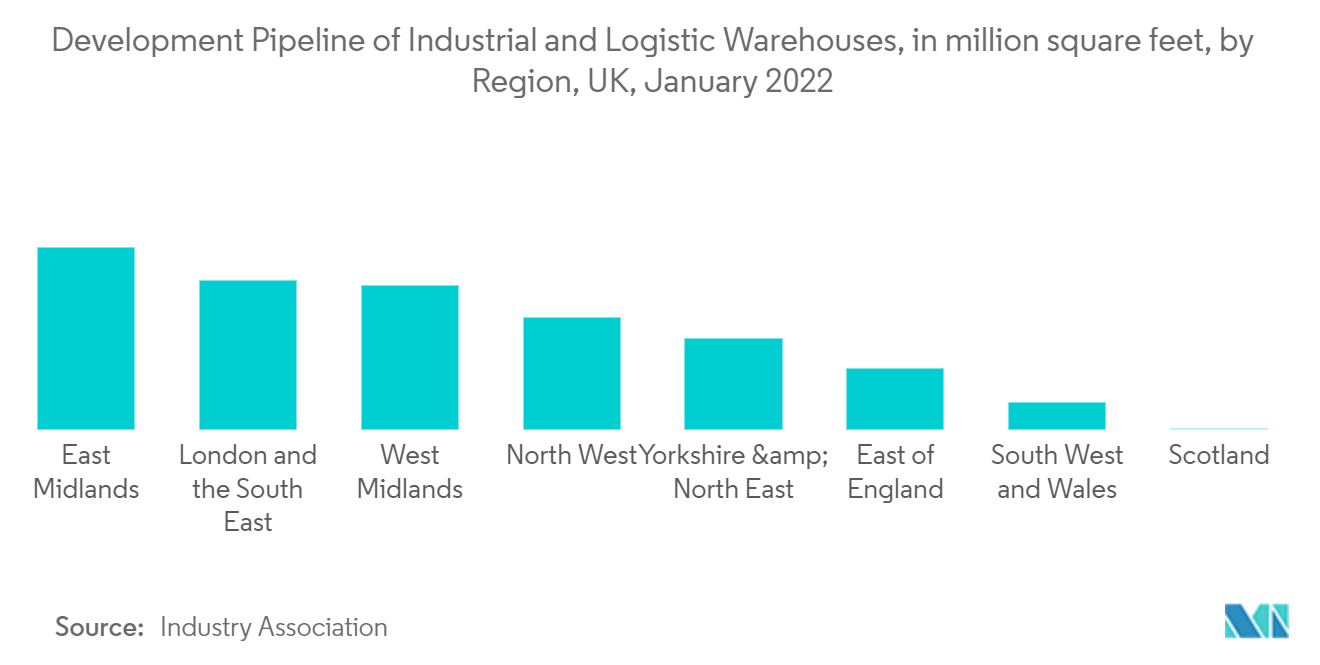
Increasing Adoption of Warehouse Automation
In the next few years, automation is expected to be more productive and worth more money than human labor. Businesses worldwide are automating warehouses in response to changing operational environments. Increasing labor expenses, a labor shortage, and increased throughput needs are just a few of them. Furthermore, innovations in automation, such as lower costs and increased scalability, greatly boost warehouse automation. The size of the organization and the complexity of its supply chain are the key determining factors for how much businesses invest in warehouse automation technology. It's probably fair to say that automation is still in its infancy in the UK warehousing sector, and most logistics SMEs are, at best, 'partially automated'. However, the pandemic and the challenges of lockdown have made a growing number of businesses give serious thought to the benefits of automation-and, at the beginning of 2022, there were more businesses with a clear timeline and budget in place for automation than there were in the years before COVID-19.
Brexit resulted in a massive departure of EU nationals employed in the UK logistics industry. It has led to a shortfall of 330,000 people in the UK labor force, mostly in the low-skilled economy, a report by leading researchers has found. Transport and warehousing were the worst hit, with a reduction of 128,000 EU workers, or 8% of total employment in that sector. There is currently a scarcity of trained heavy goods vehicle (HGV) drivers and material handling equipment (MHE) operators within the space. This has led the industry players to look for automation. Most larger UK warehouses exceed 32 feet in height and occupy massive space. Much of this space is underutilized, and it all comes at a significant cost in a country where commercial space is at a premium. Autonomous mobile robots (AMRs) enable picking inside the tight confines of racking walls, allowing better use of space and opening the door to smaller and more affordable warehouse solutions for SMEs. Thus, more and more companies will be adopting warehouse automation in the near future.
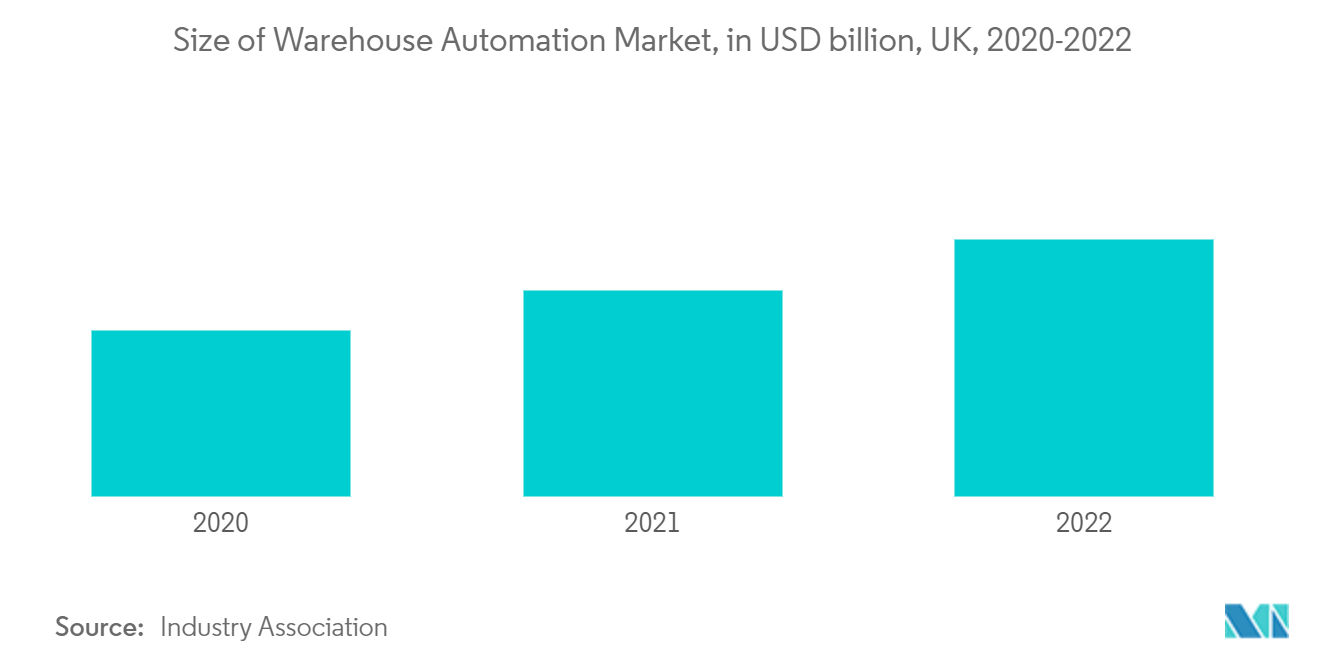
UK Warehousing & Distribution Logistics Industry Overview
The UK warehousing and distribution logistics market is highly fragmented, with the dominance of global and regional players. Some of the major players include DHL, DB Schenker, and CEVA Logistics. With a high number of companies operating in the market, the competition is very high. To gain a competitive edge over others, many players have started introducing new technologies like supply chain integration. The market is highly competitive, with players competing and partnering to gain a substantial market share.
UK Warehousing & Distribution Logistics Market Leaders
-
DHL Group
-
CEVA Logistics
-
Kuehne+Nagel
-
DB Schenker
-
Rhenus Logistics
*Disclaimer: Major Players sorted in no particular order
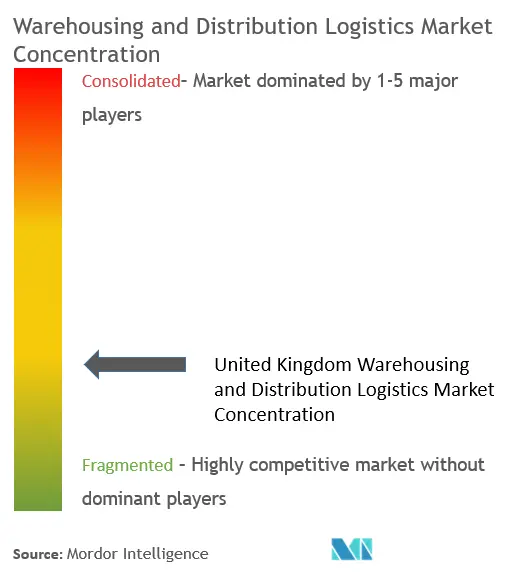
UK Warehousing & Distribution Logistics Market News
- August 2022: DHL Supply Chain, the world's leading contract logistics provider, is extending its strategic partnership with Nestlé Nespresso S.A., the company announced today. Building on a relationship dating back to 2014, DHL will now also provide logistics and fulfillment services in the UK and the Republic of Ireland (ROI). The existing partnerships between DHL and Nespresso in Italy, Brazil, Malaysia, and Taiwan will continue. From Q1 2023, DHL will handle all warehousing across Nespresso's e-commerce and network of retail boutiques in the UK and ROI. Projected to handle six million orders in year one alone, the UK operation will be based in a dedicated omnichannel facility in Coventry.
- November 2022: Birmingham-based logistics and warehouse company PGS Global Logistics is investing GBP 10 million (USD 11.2 million) in a purpose-built warehouse in West Bromwich, UK. The announcement follows a two-year search for a suitable West Midlands site amid increasing demand for warehousing in the region. The West Bromwich site will be solar-powered throughout.
UK Warehousing & Distribution Logistics Market Report - Table of Contents
1. INTRODUCTION
- 1.1 Study Assumptions and Market Definition
- 1.2 Scope of the Study
2. RESEARCH METHODOLOGY
- 2.1 Analysis Methodology
- 2.2 Research Phases
3. EXECUTIVE SUMMARY
4. MARKET INSIGHTS
- 4.1 Current Market Scenario
- 4.2 Value Chain / Supply Chain Analysis
- 4.3 Technological Developments in Warehousing
- 4.4 Government Regulations
- 4.5 Insights into Warehousing Rents
- 4.6 Insights into General Warehousing
- 4.7 Insights into Dangerous Goods Warehousing
- 4.8 Insights into Refrigerated Warehousing
- 4.9 Insights into Effects of E-commerce Growth
- 4.10 Insights into Free Zones and Industrial Parks
- 4.11 Impact of COVID-19 on the Market
-
4.12 Market Dynamics
- 4.12.1 Market Drivers
- 4.12.2 Market Restraints
- 4.12.3 Market Opportunities
- 4.12.4 Industry Attractiveness - Porter's Five Forces Analysis
- 4.12.4.1 Bargaining Power of Buyers/Consumers
- 4.12.4.2 Bargaining Power of Suppliers
- 4.12.4.3 Threat of New Entrants
- 4.12.4.4 Threat of Substitute Products
- 4.12.4.5 Intensity of Competitive Rivalry
5. MARKET SEGMENTATION
-
5.1 By End-User
- 5.1.1 Manufacturing
- 5.1.2 Consumer Goods
- 5.1.3 Food and Beverage
- 5.1.4 Retail
- 5.1.5 Healthcare
- 5.1.6 Other End-Users
6. COMPETITIVE LANDSCAPE
- 6.1 Market Concentration Overview
-
6.2 Company Profiles
- 6.2.1 DHL
- 6.2.2 Kuehne + Nagel
- 6.2.3 CEVA Logistics
- 6.2.4 DB Schenker
- 6.2.5 Rhenus Logistics
- 6.2.6 Wincanton PLC
- 6.2.7 Yusen Logistics
- 6.2.8 Fullers Logistics
- 6.2.9 Apex Logistics
- 6.2.10 Expeditors
- 6.2.11 CDL Logistics
- 6.2.12 Whistl*
- *List Not Exhaustive
7. FUTURE OF THE MARKET
8. APPENDIX
- 8.1 Macroeconomic Indicators (GDP Distribution, by Activity, and Insights on Capital Inflows)
- 8.2 External Trade Statistics - Exports and Imports
UK Warehousing & Distribution Logistics Industry Segmentation
Warehousing is one of the most important parts of this rapidly growing industry. It is mainly about storing goods that are going to be moved, either in or out.Distribution has to do with managing the flow of goods between where they are made and where they are used.The core objective of the warehouse and distribution logistics sector is to send the right product to the right destination on time, on budget, and with end-to-end visibility.
The UK warehousing and distribution logistics market is split up by end user, which includes manufacturing, consumer goods, food and beverage, retail, healthcare, and other end users. For all of the above segments, the report gives market size and forecasts in terms of value (in USD billion) for the UK warehousing and distribution logistics market.
| By End-User | Manufacturing |
| Consumer Goods | |
| Food and Beverage | |
| Retail | |
| Healthcare | |
| Other End-Users |
UK Warehousing & Distribution Logistics Market Research FAQs
What is the current United Kingdom Warehousing and Distribution Logistics Market size?
The United Kingdom Warehousing and Distribution Logistics Market is projected to register a CAGR of greater than 5% during the forecast period (2024-2029)
Who are the key players in United Kingdom Warehousing and Distribution Logistics Market?
DHL Group, CEVA Logistics, Kuehne+Nagel, DB Schenker and Rhenus Logistics are the major companies operating in the United Kingdom Warehousing and Distribution Logistics Market.
What years does this United Kingdom Warehousing and Distribution Logistics Market cover?
The report covers the United Kingdom Warehousing and Distribution Logistics Market historical market size for years: 2019, 2020, 2021, 2022 and 2023. The report also forecasts the United Kingdom Warehousing and Distribution Logistics Market size for years: 2024, 2025, 2026, 2027, 2028 and 2029.
UK Warehousing & Distribution Logistics Industry Report
Statistics for the 2024 UK Warehousing & Distribution Logistics market share, size and revenue growth rate, created by Mordor Intelligence™ Industry Reports. UK Warehousing & Distribution Logistics analysis includes a market forecast outlook 2029 and historical overview. Get a sample of this industry analysis as a free report PDF download.



